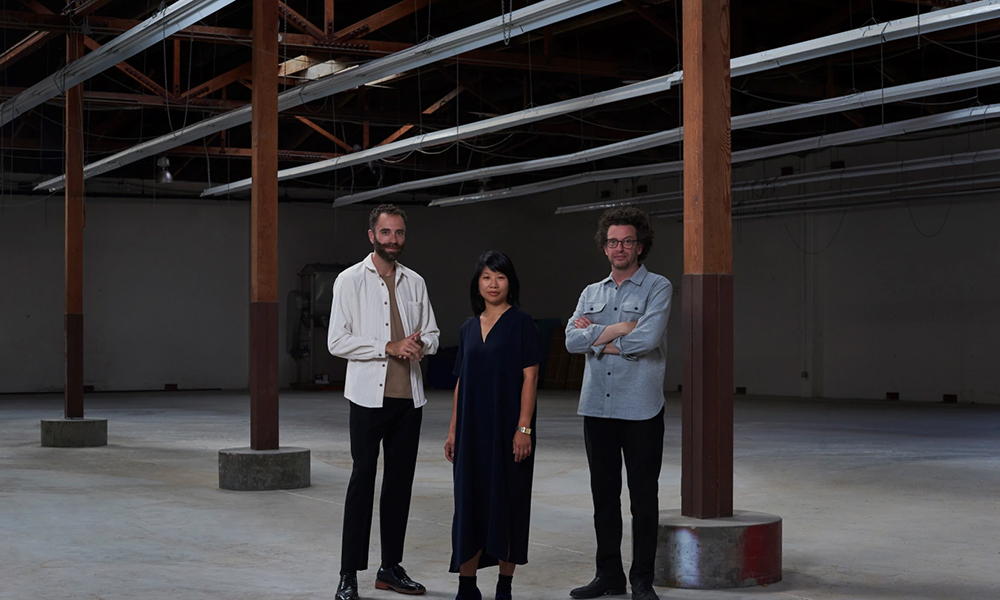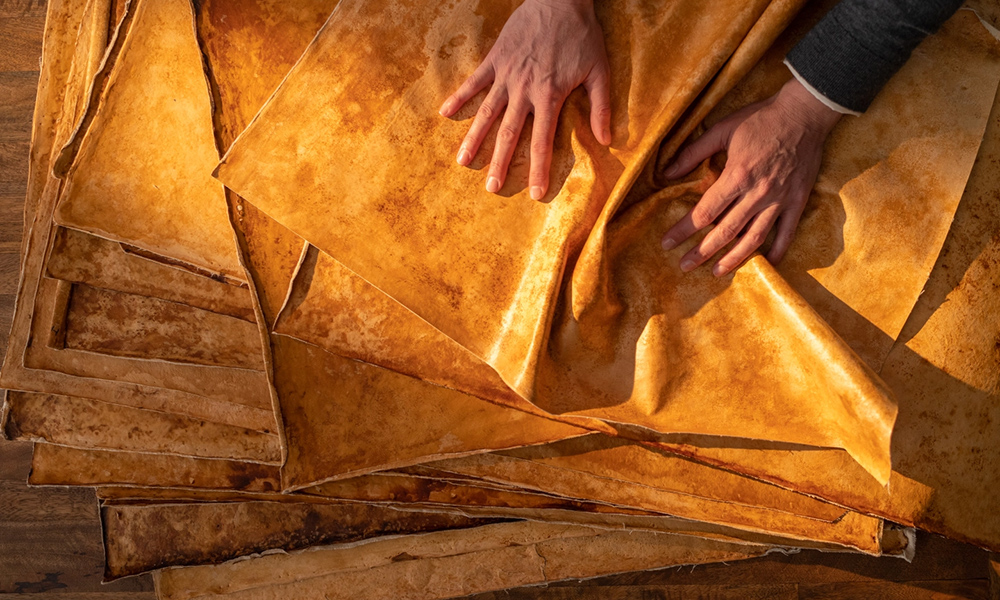以假乱真的“蘑菇皮”火了,爱马仕用来做手袋

菲尔·罗斯刚开始一头钻进蘑菇的世界里时,并没有想过要发明一种新的服装材料,但现在,他和他人共同创造的真菌“皮革”已经用于制作爱马仕(Hermès)的奢侈品手袋了,并且在不久的将来还将用作通用汽车(GM)的电动汽车的内饰。
“对未来的塑造才刚刚开始。这个行业将继续给人们惊喜。”罗斯说。
20世纪80年代末到90年代初,罗斯在美国旧金山的艺术学校进修时知道了灵芝的存在,根据中医的说法,灵芝有助于提升人体免疫力。当时罗斯在临终关怀中心为癌症和艾滋病(AIDS)的患者提供服务来维持生计,于是开始在家里为病人们种植灵芝。在近距离观察中,他注意到,灵芝丝状的根(即菌丝体)的可塑性很高,能够赋予其多种多样的颜色、形状、密度和质地——既可以像织物,也能够是像砖头一样的立体结构。罗斯成为了菌丝体艺术家——而且相当成功,他曾经在纽约现代艺术博物馆(MoMA)、杜塞尔多夫美术馆(Kunsthalle Düsseldorf)和莫斯科双年展(Moscow Biennale)上展出他的菌丝体作品。
“事实上,菌丝体正是这样向世界展示了它是一种有趣的功能性设计材料。”诗歌博士索菲娅·王说。索菲娅于2007年与罗斯相遇,之后两人合作了一些艺术项目。六年后,两人联合创立了MycoWorks,发明生产菌丝体材料。
发现菌丝体的可塑性是迈向突破的一步。第二步发生在2016年,那一年,罗斯和王从制造菌丝体块(质量轻、天然防火,但作为商品则需要大规模生产)转向了制造类似皮革的柔性菌丝体材料。罗斯和王意识到,菌丝体“皮革”可以吸引那些因为天然皮革使用动物制品且带有化学污染物而对此止步的消费者。

如今,MycoWorks已经筹集了超过1.87亿美元的风险投资——投资者包括娜塔莉·波特曼和约翰·传奇,他们在美国南卡罗来纳州的工厂也已经开工,每年生产数百万平方英尺的灵芝精细菌丝体仿皮革材料。爱马仕是该公司高级时尚行业的客户,今年10月,MycoWorks还宣布收到通用汽车(General Motors)旗下通用风险投资公司(GM Ventures)未明确项目的投资,用于生产“可持续汽车材料”,用作汽车内饰等。MycoWorks拒绝提供该公司的估值或营收,公司约有200名员工。
2017年加入公司担任首席执行官的材料科学博士马特·斯卡林说:“当前,越来越多的人希望购买来源明确、可追溯、碳足迹更低、用水量更低的可持续产品,品牌们都在做出重大调整以满足上述需求,而这些要求菌丝体全部能够做到。”
皮革厂与石油
动物皮革是一个肮脏的行业。麻省理工学院(MIT)的材料系统实验室(Materials Systems Lab)的一项研究显示,皮革每年向地球排放约1.3亿吨二氧化碳,相当于3,000万辆汽车。
由于消费者对环境和动物权益的担忧加剧,过去十年,资金大量涌入生物材料领域。
位于美国加州纳帕的材料创新倡议(Materials Innovation Initiative)在其2021年对“下一代”材料行业(包括从植物、微生物、回收利用物和人工培育的动物细胞中提取的材料)的研究中发现:2015年以来,对该行业的投资已经高达23亿美元,其中2021年为9.8亿美元,是2020年的两倍;全球40个顶级时尚品牌中已经有38个在积极搜寻下一代材料。
“很多投资者都对合成生物学颇感兴趣。菌丝体就是其中之一。”材料创新倡议的首席创新官伊莱恩·西乌说:“投资者之所以感兴趣,是因为这个领域存在大量高价值知识产权。生物学真正代表了下一个阶段:革命。”
西乌称,下一代材料的发展比植物肉产业滞后了大约五年。进度缓慢的其中一个原因是很难得到大自然母亲的配合:“生物学需要时间。”她说。
在黑暗中生长
罗斯和王花了几年时间才弄清楚种植蘑菇皮的最佳方式。在这个过程中,几英寸深的托盘里装满了木屑、营养物质和水,浸渍了真菌菌种。真菌吞噬基质,在黑暗、控温的托盘中生长,托盘尺寸为2乘3英尺,这是半块牛皮的行业标准。真菌包裹在基质上,在基质上长出一块质地坚实又轻盈的面板,这是一层白色的菌丝体——也就是皮革。几周后,菌丝体最终可以像杏仁糖蛋糕上的糖霜一样剥离。王解释道:“从某种意义上说,之所以会长出这一层,是为了保护它们的食物来源。”

在“皮革”生长之前,能够在托盘中放入一层编织或合成材料,甚至可以放入防弹的凯夫拉纤维,菌丝体能够穿透这层材料生长,增加强度或纹理。最后,再对菌丝体片进行鞣制和染色。
斯卡林说,该公司在美国加州埃默里维尔的试点生产线上已经种植了“数以万计的”托盘。
商品
菌丝体皮革仍然比动物皮革贵。MycoWorks拒绝透露价格,但其竞争对手Bolt Threads告诉彭博社(Bloomberg),该公司的产品约为每平方英尺25美元,与质量上乘的小牛皮价格类似,所以第一批使用这种材料的产品来自奢侈品界。
爱马仕在法国的皮革工匠将MycoWorks的精细菌丝体转变成一种琥珀色材料,将其命名为“西尔瓦尼亚”(Sylvania)。爱马仕用这种材料制作了“维多利亚”(Victoria)包的真菌版,价值4,200美元,预计将在未来几个月交付。爱马仕表示,三年的合作“将制作高品质材料的专业技能与生物技术工具相结合”。斯特拉·麦卡特尼使用其竞争对手Bolt Threads的菌丝体材料制作了100个价值3,500美元的限量版Frayme Mylo单肩包。(斯卡林说,MycoWorks和友商的区别在于,MycoWorks种植的是一整块菌丝,其他公司则是用聚氨酯将一片片菌丝粘合起来。)
美国加州威尼斯的帽子制造商Nick Fouquet是第一家销售菌丝体帽子的品牌,今年7月上市,售价700美元一顶,共40顶。他说,成品和皮革非常相似,连公司的女裁缝都看不出其中区别。唯一的不同在于气味,它散发的是“泥土气息”。(MycoWorks现在的鞣制工艺已经可以让蘑菇皮拥有皮革的气味,但供给Fouquet的第一批材料还未使用。)
通用汽车对MycoWorks的投资,旨在实现电动汽车内饰与发动机同样环保。对汽车制造商而言,这种材料还有其他优势。王说:“汽车行业对我们的材料感兴趣的原因之一是,它能够薄达0.2毫米,是皮革厚度的一半。所以在重量和可塑性上都更有优势。”
当然,菌丝体皮革的发展仍然处于初级阶段,它能否像GoreTex一样取得巨大成功仍然是未知数。市场研究公司似乎没有就该行业的前景达成共识。北极星市场研究公司(Polaris Market Research)认为,“生物基皮革”市场将从2021年的6.47亿美元增长到2030年的11亿美元,年增长率为6.2%。英菲尼姆全球研究公司(Infinium Global Research)预测,该市场将从2020年的2.36亿美元增长到2027年的35亿美元,年增长率为47%。
斯卡林相信,随着价格下降和产量提升,菌丝体皮革可以取代市场上现有的大部分材料——不仅仅是牛皮。
“业界想要的是一种能够让它们打入一个不断增长的新兴市场的材料,满足消费者对可持续材料和品质更高的材料的需求。它们不是在寻找皮革的替代品。”他说。相反,由于其温暖、“有活力”的质地,菌丝体皮革将成为一种新选择,可以轻松取代当前占据皮革市场一半以上份额的“聚氨酯合成革”。
其他人则想要更进一步,回到MycoWorks的初始产品。麻省理工学院的比特与原子研究中心(Center for Bits and Atoms)的研究科学家安德烈亚斯·梅尔申和建筑师克里斯·毛雷尔正在主持一个项目,用牡蛎蘑菇菌丝体制成的砖块在纳米比亚建造房屋。
“想想看,不再需要运输任何建筑材料。只需要运输孢子,然后在当地找任意现成的材料进行接种。你就能够在现场种植建筑材料了。”罗德岛设计学院自然实验室(RISD Nature Lab)的临时主任詹妮弗·比索内特说:“它在生产住房和食物来源。想想这些微生物可以满足人类的各种基本需求,简直不可思议。”(财富中文网)
译者:Agatha
菲尔·罗斯刚开始一头钻进蘑菇的世界里时,并没有想过要发明一种新的服装材料,但现在,他和他人共同创造的真菌“皮革”已经用于制作爱马仕(Hermès)的奢侈品手袋了,并且在不久的将来还将用作通用汽车(GM)的电动汽车的内饰。
“对未来的塑造才刚刚开始。这个行业将继续给人们惊喜。”罗斯说。
20世纪80年代末到90年代初,罗斯在美国旧金山的艺术学校进修时知道了灵芝的存在,根据中医的说法,灵芝有助于提升人体免疫力。当时罗斯在临终关怀中心为癌症和艾滋病(AIDS)的患者提供服务来维持生计,于是开始在家里为病人们种植灵芝。在近距离观察中,他注意到,灵芝丝状的根(即菌丝体)的可塑性很高,能够赋予其多种多样的颜色、形状、密度和质地——既可以像织物,也能够是像砖头一样的立体结构。罗斯成为了菌丝体艺术家——而且相当成功,他曾经在纽约现代艺术博物馆(MoMA)、杜塞尔多夫美术馆(Kunsthalle Düsseldorf)和莫斯科双年展(Moscow Biennale)上展出他的菌丝体作品。
“事实上,菌丝体正是这样向世界展示了它是一种有趣的功能性设计材料。”诗歌博士索菲娅·王说。索菲娅于2007年与罗斯相遇,之后两人合作了一些艺术项目。六年后,两人联合创立了MycoWorks,发明生产菌丝体材料。
发现菌丝体的可塑性是迈向突破的一步。第二步发生在2016年,那一年,罗斯和王从制造菌丝体块(质量轻、天然防火,但作为商品则需要大规模生产)转向了制造类似皮革的柔性菌丝体材料。罗斯和王意识到,菌丝体“皮革”可以吸引那些因为天然皮革使用动物制品且带有化学污染物而对此止步的消费者。
如今,MycoWorks已经筹集了超过1.87亿美元的风险投资——投资者包括娜塔莉·波特曼和约翰·传奇,他们在美国南卡罗来纳州的工厂也已经开工,每年生产数百万平方英尺的灵芝精细菌丝体仿皮革材料。爱马仕是该公司高级时尚行业的客户,今年10月,MycoWorks还宣布收到通用汽车(General Motors)旗下通用风险投资公司(GM Ventures)未明确项目的投资,用于生产“可持续汽车材料”,用作汽车内饰等。MycoWorks拒绝提供该公司的估值或营收,公司约有200名员工。
2017年加入公司担任首席执行官的材料科学博士马特·斯卡林说:“当前,越来越多的人希望购买来源明确、可追溯、碳足迹更低、用水量更低的可持续产品,品牌们都在做出重大调整以满足上述需求,而这些要求菌丝体全部能够做到。”
皮革厂与石油
动物皮革是一个肮脏的行业。麻省理工学院(MIT)的材料系统实验室(Materials Systems Lab)的一项研究显示,皮革每年向地球排放约1.3亿吨二氧化碳,相当于3,000万辆汽车。
由于消费者对环境和动物权益的担忧加剧,过去十年,资金大量涌入生物材料领域。
位于美国加州纳帕的材料创新倡议(Materials Innovation Initiative)在其2021年对“下一代”材料行业(包括从植物、微生物、回收利用物和人工培育的动物细胞中提取的材料)的研究中发现:2015年以来,对该行业的投资已经高达23亿美元,其中2021年为9.8亿美元,是2020年的两倍;全球40个顶级时尚品牌中已经有38个在积极搜寻下一代材料。
“很多投资者都对合成生物学颇感兴趣。菌丝体就是其中之一。”材料创新倡议的首席创新官伊莱恩·西乌说:“投资者之所以感兴趣,是因为这个领域存在大量高价值知识产权。生物学真正代表了下一个阶段:革命。”
西乌称,下一代材料的发展比植物肉产业滞后了大约五年。进度缓慢的其中一个原因是很难得到大自然母亲的配合:“生物学需要时间。”她说。
在黑暗中生长
罗斯和王花了几年时间才弄清楚种植蘑菇皮的最佳方式。在这个过程中,几英寸深的托盘里装满了木屑、营养物质和水,浸渍了真菌菌种。真菌吞噬基质,在黑暗、控温的托盘中生长,托盘尺寸为2乘3英尺,这是半块牛皮的行业标准。真菌包裹在基质上,在基质上长出一块质地坚实又轻盈的面板,这是一层白色的菌丝体——也就是皮革。几周后,菌丝体最终可以像杏仁糖蛋糕上的糖霜一样剥离。王解释道:“从某种意义上说,之所以会长出这一层,是为了保护它们的食物来源。”
在“皮革”生长之前,能够在托盘中放入一层编织或合成材料,甚至可以放入防弹的凯夫拉纤维,菌丝体能够穿透这层材料生长,增加强度或纹理。最后,再对菌丝体片进行鞣制和染色。
斯卡林说,该公司在美国加州埃默里维尔的试点生产线上已经种植了“数以万计的”托盘。
商品
菌丝体皮革仍然比动物皮革贵。MycoWorks拒绝透露价格,但其竞争对手Bolt Threads告诉彭博社(Bloomberg),该公司的产品约为每平方英尺25美元,与质量上乘的小牛皮价格类似,所以第一批使用这种材料的产品来自奢侈品界。
爱马仕在法国的皮革工匠将MycoWorks的精细菌丝体转变成一种琥珀色材料,将其命名为“西尔瓦尼亚”(Sylvania)。爱马仕用这种材料制作了“维多利亚”(Victoria)包的真菌版,价值4,200美元,预计将在未来几个月交付。爱马仕表示,三年的合作“将制作高品质材料的专业技能与生物技术工具相结合”。斯特拉·麦卡特尼使用其竞争对手Bolt Threads的菌丝体材料制作了100个价值3,500美元的限量版Frayme Mylo单肩包。(斯卡林说,MycoWorks和友商的区别在于,MycoWorks种植的是一整块菌丝,其他公司则是用聚氨酯将一片片菌丝粘合起来。)
美国加州威尼斯的帽子制造商Nick Fouquet是第一家销售菌丝体帽子的品牌,今年7月上市,售价700美元一顶,共40顶。他说,成品和皮革非常相似,连公司的女裁缝都看不出其中区别。唯一的不同在于气味,它散发的是“泥土气息”。(MycoWorks现在的鞣制工艺已经可以让蘑菇皮拥有皮革的气味,但供给Fouquet的第一批材料还未使用。)
通用汽车对MycoWorks的投资,旨在实现电动汽车内饰与发动机同样环保。对汽车制造商而言,这种材料还有其他优势。王说:“汽车行业对我们的材料感兴趣的原因之一是,它能够薄达0.2毫米,是皮革厚度的一半。所以在重量和可塑性上都更有优势。”
当然,菌丝体皮革的发展仍然处于初级阶段,它能否像GoreTex一样取得巨大成功仍然是未知数。市场研究公司似乎没有就该行业的前景达成共识。北极星市场研究公司(Polaris Market Research)认为,“生物基皮革”市场将从2021年的6.47亿美元增长到2030年的11亿美元,年增长率为6.2%。英菲尼姆全球研究公司(Infinium Global Research)预测,该市场将从2020年的2.36亿美元增长到2027年的35亿美元,年增长率为47%。
斯卡林相信,随着价格下降和产量提升,菌丝体皮革可以取代市场上现有的大部分材料——不仅仅是牛皮。
“业界想要的是一种能够让它们打入一个不断增长的新兴市场的材料,满足消费者对可持续材料和品质更高的材料的需求。它们不是在寻找皮革的替代品。”他说。相反,由于其温暖、“有活力”的质地,菌丝体皮革将成为一种新选择,可以轻松取代当前占据皮革市场一半以上份额的“聚氨酯合成革”。
其他人则想要更进一步,回到MycoWorks的初始产品。麻省理工学院的比特与原子研究中心(Center for Bits and Atoms)的研究科学家安德烈亚斯·梅尔申和建筑师克里斯·毛雷尔正在主持一个项目,用牡蛎蘑菇菌丝体制成的砖块在纳米比亚建造房屋。
“想想看,不再需要运输任何建筑材料。只需要运输孢子,然后在当地找任意现成的材料进行接种。你就能够在现场种植建筑材料了。”罗德岛设计学院自然实验室(RISD Nature Lab)的临时主任詹妮弗·比索内特说:“它在生产住房和食物来源。想想这些微生物可以满足人类的各种基本需求,简直不可思议。”(财富中文网)
译者:Agatha
Phil Ross had no plans to create a new clothing material when he dove deep into the world of mushrooms, but now the fungi-based “leather” he helped pioneer can be found in Hermès’s luxury handbags and could soon coat the interior of GM’s electric cars.
“Growing the future has only just started. This industry will continue to surprise people,” says Ross.
Ross discovered reishi mushrooms, a fungus used in traditional Chinese medicine to aid the immune system, in art school in San Francisco in the late ’80s and early ’90s. At at that time, he supported himself by treating cancer and AIDS patients in hospice care. Ross began growing the mushrooms at home for his patients. As he studied them up close, he noticed how their silk-threadlike roots, known as mycelium, grew together into a moldable material that could attain a wide range of color and form and density and texture—from fabric to brick-like three-dimensional structures. Ross became a mycelium artist—a pretty successful one, too—showing his fungus-based in the MoMA, Kunsthalle Düsseldorf, and the Moscow Biennale.
“And this is essentially how mycelium as an interesting functional design material becomes more visible in the world,” says Sophia Wang, a poetry Ph.D. who collaborated on art projects with Ross after meeting him in 2007. Six years later, the two cofounded MycoWorks, a mycelium material inventor and manufacturer.
Discovering the adaptability of mycelium was one step toward a breakthrough. The second occurred in 2016 when Ross and Wang pivoted away from mycelium blocks—they are lightweight and naturally fireproof, but as a commodity product would need massive scale—toward flexible mycelium materials designed to perform like leather. Mycelium “leather,” Ross and Wang realized, could appeal to consumers turned off by the real stuff because of its chemical pollutants and use of animal products.
Today, MycoWorks has raised over $187 million in venture funding—from investors that include Natalie Portman and John Legend—and has broken ground on a South Carolina factory to annually produce several million square feet of its Reishi Fine Mycelium leather-like material. It counts Hermès as a high-fashion client and in October announced an unspecified investment from General Motors’ funding arm, GM Ventures, to produce “sustainable automotive materials,” including for car upholstery. MycoWorks declined to provide the company’s valuation or revenues. It has about 200 employees.
“Brands are making very significant changes to address what is really a growing demographic of people who want to buy sustainable products that have provenance and traceability and a lower carbon footprint, lower water use—and mycelium does all of those things,” says Matt Scullin, the materials science Ph.D. who joined as CEO in 2017.
Tanneries and oil
Animal leather is a dirty business. According to a study from MIT’s Materials Systems Lab, leather contributes the equivalent of 130 million tons of CO2 to the earth annually—equivalent to the emissions of 30 million cars each year.
Amid consumers’ heightened environmental and animal rights concerns, money has poured into biomaterials in the past decade.
In its 2021 study of the “next-gen” material industry, which covers materials derived from plants, microbes, recycling, and cultivated animal cells, Materials Innovation Initiative (MII), based in Napa, Calif., identified $2.3 billion in investment in the industry since 2015, including $980 million in 2021—double 2020’s total—and found that 38 out of 40 top fashion brands were actively searching for next-gen materials.
“A lot of investors are interested in synthetic biology. Mycelium is that,” says Elaine Siu, MII’s chief innovation officer. “Investors are interested because there’s a lot of valuable IP. Biology is really the next phase: the revolution.”
Siu says next-gen materials are about five years behind the plant-based meat industry in development. One reason for the slow rollout is the difficulty of getting Mother Nature to play along: “Biology takes time,” she says.
Growing in the dark
It took several years for Ross and Wang to determine how best to grow mushroom leather. In the process they landed on, trays several inches deep are filled with sawdust, nutrients, and water and impregnated with fungal spawn. The fungus eats the substrate and grows in the dark, temperature-controlled tray that measures two by three feet, the industry standard for half a cowhide. The fungus envelops the substrate and forms a hard, lightweight panel, and a white sheet of mycelium—the leather—grows on top of it. Eventually, the mycelium can be peeled off like a marzipan cake icing after several weeks. “In a way it’s growing the layer to protect the food source,” Wang explains.
Before that “leather” grows, a layer of woven or synthetic material—even bullet-resistant Kevlar—can be placed in the tray and the mycelium grows through it, adding strength or texture. Finally, the Fine Mycelium sheet is tanned and dyed.
The company has grown “tens of thousands” of trays at its pilot line in Emeryville, Calif., Scullin says.
The goods
Mycelium leather is still more expensive than the animal variety. MycoWorks declined to specify its price, but competitor Bolt Threads told Bloomberg its material costs about $25 per square foot, similar to high-quality calf leather, so the first products using it have come out of the luxury goods world.
Hermès tanners in France turned MycoWorks Fine Mycelium into an amber-hued material it calls Sylvania that the brand used to create a fungus version of its $4,200 “Victoria” bag, which is expected to be delivered in the coming months. Hermès says the three-year collaboration “pairs expertise in tanning the highest-quality materials with the tools of biotechnology.” Stella McCartney used mycelium material Mylo from competitor Bolt Threads for a limited run of 100 $3,500 Frayme Mylo shoulder bags. (Scullin says the difference between MycoWorks and its competitors is that MycoWorks grows sheets of mycelium while others bind pieces of mycelium with polyurethane.)
Hatmaker Nick Fouquet, based in Venice, Calif., was the first to sell gear made with Fine Mycelium—40 hats for about $700 each—in July. He says the finish was so similar to leather that his production seamstress didn’t know the difference. The only real distinction was in the scent, which was much more of an “earth tone.” (Fouquet’s first sheets had not gone through the same tanning process MycoWorks now uses, which gives the material a leather scent.)
GM’s investment in MycoWorks is part of push to make the interior of electric cars equally as environmentally friendly as the engine. The material has other advantages for carmakers. “One of the reasons that the auto industry is interested in our material is that it can be .2 millimeters thin, which is half the thickness that they can get leather. So there’s an advantage in terms of weight and also mold-ability,” says Wang.
Mycelium leather is still in its infancy, of course, and whether it will become a giant hit like GoreTex is still unknown. Market research firms seem to have reached little consensus as to what the future holds. Polaris Market Research sees the “bio-based leather” market growing by 6.2% annually from $647 million in 2021 to $1.1 billion in 2030, while Infinium Global Research has it rising from $236 million in 2020 to $3.5 billion in 2027, a 47% annual growth rate.
Scullin is convinced that as prices come down and production ramps up, mycelium leather can replace much of what it out there today—and not just cow leather.
“What the industry wants is a material that allows them to tap into this growing market of consumers who demand sustainable materials and demand better materials. They’re not looking for a leather replacement,” he says. Rather, with its warm, “alive” texture, mycelium leathers will be an easy choice to replace the “polyurethane leathers” that account for over half of the leather market.
Others are eager to push mycelium even further—back to MycoWorks’ origins. Andreas Mershin, a research scientist at MIT’s Center for Bits and Atoms, and architect Chris Maurer are working on a project to use bricks created from oyster mushroom mycelium to build houses in Namibia.
“Think about not having to transport all those building materials. All you need to do is transport the spores, and then you can inoculate whatever kind of local material that you have there. And then you can be growing building materials on site,” says Jennifer Bissonnette, interim director of the RISD Nature Lab. “It’s creating housing and a food source. It’s kind of incredible to think of all those basic needs being met by these organisms.”













